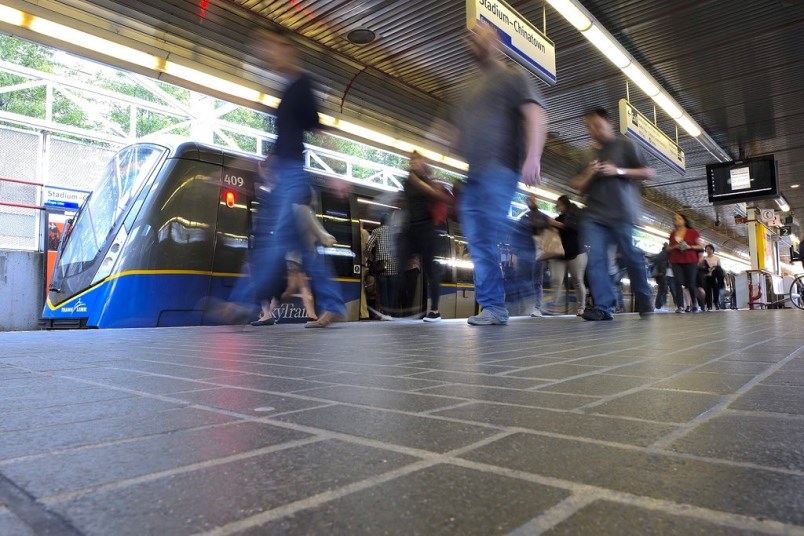They say travel broadens the mind, which in my case is a good thing, as my mind is shrinking faster than my waist size is expanding.
But here I am cruising along between Venice and Rome, via Trenitalia, the Italian national railway, expanding my mind at the rate of 249 kilometres per hour.
This morning, I left my hotel in Venice near the Piazza San Marco, shooed away the pigeon panhandlers in the square, and made my way to the stop for the Vaporetto, the Venetian public transit that travels along the Grand Canal. It’s kind of a SeaBus with an Italian accent, which makes it sound more chic and sophisticated than it really is.
But the Vaporetto pilots are incredibly adept at navigating the often choppy waters of the Grand Canal, and the ride from the piazza to Ferrovia (the train station, literally “iron way”) took less than 30 minutes.
It’s the equivalent of taking the SeaBus to the Canada Line to YVR, only in Europe, there’s another option not available here – the high speed electric train.
The timing for this mind-expanding trip is fortuitous, as it comes in the wake of last week’s announcement that the province will study the feasibility of a rapid transit line connecting the North Shore with downtown Vancouver; at the same time, it will also look at expanding the SeaBus system.
So, tutti in una volta, I’m experiencing the thrill of pokey but practical water conveyance coupled with high speed fixed rail traffic, in a place that (according to Ariane, our fiercely knowledgeable Venetian tour guide) welcomes 28 million visitors a year and somehow schlepps them around with relative ease.
Did I mention there are no cars allowed in Venice? It was an easy decision because there are no roads, so they’ve learned to do without. The result has been so successful that this year, they expect 32 million visitors.
This in a town with less than 55,000 permanent inhabitants.
This includes the nearly 400 gondoliers, who will take you underneath the Rialto Bridge and through the warren of little canals, only 80 Euros for a half-hour ride. A bit of a digression (who, me?): only one of those gondoliers is a woman.
The point of this reflection is that it’s possible to get around without the automobile, even easier in a place that has never had them. Venice belongs in a parallel universe in many respects, but about this there’s no dispute: it’s the original car-free settlement.
This is instructive to a mind that routinely descends to an underground parking lot in the morning, climbs into the SUV, drives to the lineup for the Lions Gate Bridge, finally ending up in another underground parking lot in downtown Vancouver; repeats the process in reverse in the evening, and sees nothing wrong.
Ugh.
Spend a little time in a parallel universe and a million thoughts contend. Imagine travelling along the North Shore by SeaBus, with stops on both sides of the inlet, looping in neighbourhoods from West Vancouver to Deep Cove, adding stops on the South Shore from Burnaby to UBC.
Add SkyTrain across the inlet and we’re no longer isolated from the rest of the world by the nine lanes of vehicle traffic offered up by the Ironworkers Memorial and Lions Gate bridges. That should also encourage better transit service from neighbourhoods to the connecting points.
Along the rapid route to Rome, mind expansion makes it possible to imagine a high-speed train to Kelowna or Calgary or Edmonton. Instead of pipelines, maybe.
I realize my imagination is travelling a lot faster and freer than things do in the traffic jam of the real world. The declaration by a government to study something is not the same thing as a government actually doing something. There’s a long way to travel, by any route. First the study has to determine that it’s even possible to build a bridge or a tunnel from the North Shore and it will be at least 2020 before a detailed study recommending a plan will be ready to go.
But the declaration by Transportation and Infrastructure Minister Claire Trevena is the first step in a journey to a gridlock-free existence.
You can download your own mind expansions by weighing in at transport2050.ca, where TransLink is taking feedback for the next round of transit improvements. Don’t let Surrey Mayor Doug McCallum have all the fun.
Andiamo!
Journalist and communications consultant Paul Sullivan has been a North Vancouver resident since the fall of the Berlin Wall and the rise of Madonna. p.sullivan@breakthroughpr.com



